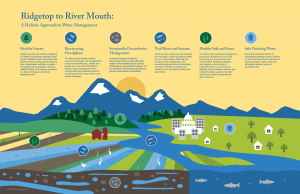By Todd Manley
In the Sacramento Valley, water resources managers work together, utilizing a nature-based approach to manage the region’s water and land resources from the ridgetop down through the system to the river mouth. This holistic approach restores biodiversity while increasing water supply reliability for cities, farms, fish, wildlife, hydropower production and recreation.
The water rights system in California supports ridgetop to river mouth multi-benefit water management as water flowing down through the system is used multiple times for multiple purposes. As an example, the return flows from one water right can be the supply for another water right. (See the key elements of the water rights system below for more details). This type of water management—where water is used multiple times through the system—is the essence of the California Constitution’s requirements contained in Article 10, Section 2, which states, “because of the conditions prevailing in this State the general welfare requires that the water resources of the State be put to beneficial use to the fullest extent of which they are capable [emphasis added], and that the waste or unreasonable use or unreasonable method of use of water be prevented, and that the conservation of such waters is to be exercised with a view to the reasonable and beneficial use thereof in the interest of the people and for the public welfare.”
In the past, multiple uses with the same quantity of water lead some to suggest the system is “over-appropriated,” with the face value of the state’s water rights totaling more than the available water in the system, thus the system is broken or flawed.
As we look to the future in the Sacramento Valley, the nature of water flowing from the ridgetop to the river mouth and being used multiple times is a very efficient use of water and helps use every drop of water multiple times to serve various beneficial uses in the region, including cities and rural communities, farms, refuges and managed wetlands, fisheries, recreation and hydropower. In this regard, the water rights priority system generally works well and provides an orderly process for this modern and forward-looking style of water management. This is particularly true in dry years. We thus appreciate the State Water Board’s efforts to implement this system through emergency regulations it adopted on August 20, 2021. Importantly, these regulations are already in place for 2022 and the State Water Board updates the curtailment notices every week based on current hydrology and the water availability throughout the Bay-Delta watershed, including the Sacramento Valley.
To be sure, the state’s water rights system is always being improved with better data, technology and the desire for better water management. In this light, the system provides an orderly process that allows the State Water Board and water right holders to work through years when there is not enough water in the system to satisfy all beneficial uses. The system also supports ridgetop to river mouth, multi-benefit, water management and facilitates our precious water resources being put to beneficial use to the fullest extent of which they are capable.
We welcome ideas and thoughts on ridgetop to river mouth water management at info@norcalwater.org.
Key Elements of the Water Rights System
To better understand the water rights system and the way water is managed it is important to consider non-consumptive water rights, the substantial water reuse and recoverable losses in the state’s water system, and the restrictions on water rights.
Consumptive and Non-Consumptive Uses. Water rights are required for all water uses – both consumptive and non-consumptive. Consumptive uses are those where the water use results in water not being available for other beneficial use. Examples of this include water consumed by a crop or household lawn. Non-consumptive uses are those where a beneficial use is achieved without the water being consumed, and thereby available to meet another beneficial use. Examples of non-consumptive water uses that require a water right include: filling a reservoir, running water through a hydroelectric or once-through cooling facility and water dedicated to meet instream flow objectives.
For context, the non-consumptive water rights to fill reservoirs, run hydroelectric facilities, address instream flow needs total tens of millions of acre-feet every year. No water is consumed to meet these water rights and all of it is available to meet other water rights (both consumptive and non-consumptive) downstream as the water moves down through the system.
Return flows. Additionally, water that is diverted and not used for crop production, lost to evapotranspiration or percolates to recharge groundwater will return to a river or stream where it is available to be diverted again, pursuant to other water rights. An example of this is water applied to farmland that is not consumed by the crop and flows into a drain where it is available to meet additional water rights. This reuse of the same water supplies can occur multiple times.
Water rights restrictions. Many water rights contain restrictions and conditions that limit diversions when water supplies are not available. The water right holder and the SWRCB recognize and understand these limitations and the role they play in allocating limited water resources. This includes the curtailments of water, which were significant and widespread in the most recent drought years.





How are Rights of Nature, Public Trust Doctrine, and indigenous water rights accommodated in the California Water Rights system?